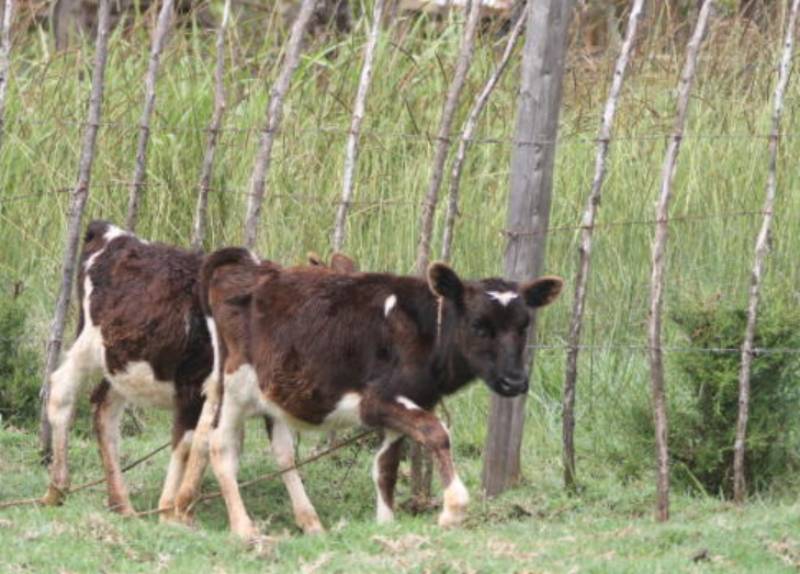
You have heard that female calves are the future of the herd. When we cull the older cows due to decreased milk production or otherwise these little ones become the replacement heifers.
Healthy calves are the central theme in modern dairy farming business. How do you take care of your calves from birth to 3 months?
At calving; When the cow has given birth, ensure you wipe the nostrils of the calf to induce normal breathing.
In case there were delays in giving birth, you may consider holding up the legs of the calf to raise it in the air such that the head is lower than the body then swinging it gently side by side. This helps to draining any fluids from its nostril via gravity.
Feeding of colostrum; Colostrum is the first milk produced by the cow after giving birth. Its thick and yellow.
It contains antibodies and other elements that provide the calf with immunity before its own immunity develops with time.
The calf can only benefit from these antibodies within the first 24 hours since birth and therefore it should ingest a good amount of colostrum immediately after birth.
Suckling allows better uptake of these antibodies than bucket milk according to research.
Feeding of milk: After colostrum, the cow produces normal milk.
A calf should get milk equivalent to 10% of its body weight so as to achieve a daily weight gain of 500 grams.
Assuming the calf weighs 50 kilos at birth, it should get at least 5 litres of milk daily. This amount can be divided into 2 or 3 portions to be fed in the morning, over lunch hour and in the evening.
The calf should take the milk immediately after milking when the milk is still hot.
Water intake; In the warm weather provide limited amounts of water, say one litre, for the calf to drink.
You can warm this water for the calf during cold weather. Young calves are naïve and cannot limit the amount of water they drink.
Stay informed. Subscribe to our newsletter
Failure to limit water intake prompts the calf to over drink which causes red urine. Once the calf grows up avail the water all the time (ad libitum).
Feeding of calf pellets; These are energy-rich and can be added to the milk from around the third week.
At first, add small portions – a few spoonsful - and increase gradually to avoid digestion problems. This practise promotes the development of the fore stomachs – rumen and reticulum - of the calf and places the calf at an advantage position to start feeding on dry matter early enough.
Salt supplementation; While the cow’s milk contains mineral salts, they are not sufficient for the rapidly growing calf.
Salt blocks can be provided to cover the deficit by licking. Salt blocks are available in Agro vets and Veterinary pharmacies countrywide.
Deworming and tick control; This is done to control worms and ticks when the calves are allowed to graze with other cows.
Additionally, in well paddocked pastures, let in calves first and then the cows.
Social support; A calf should be allowed the company of other calves which are of two weeks’ age difference.
They form a ‘kindergarten’ when they learn to run, sleep and play together and stimulate drinking, eating and being active.
Social skin care including licking seen among very young calves are signs that they’ve established a strong bond. These bonds can last until they become cows.
Armed with this information you can now raise healthy heifers for continuity of your dairy farm.
Author; Dr. Paul R. N. Kang’ethe (BVM, UoN)
Email; [email protected]
 The Standard Group Plc is a
multi-media organization with investments in media platforms spanning newspaper
print operations, television, radio broadcasting, digital and online services. The
Standard Group is recognized as a leading multi-media house in Kenya with a key
influence in matters of national and international interest.
The Standard Group Plc is a
multi-media organization with investments in media platforms spanning newspaper
print operations, television, radio broadcasting, digital and online services. The
Standard Group is recognized as a leading multi-media house in Kenya with a key
influence in matters of national and international interest.
 The Standard Group Plc is a
multi-media organization with investments in media platforms spanning newspaper
print operations, television, radio broadcasting, digital and online services. The
Standard Group is recognized as a leading multi-media house in Kenya with a key
influence in matters of national and international interest.
The Standard Group Plc is a
multi-media organization with investments in media platforms spanning newspaper
print operations, television, radio broadcasting, digital and online services. The
Standard Group is recognized as a leading multi-media house in Kenya with a key
influence in matters of national and international interest.








